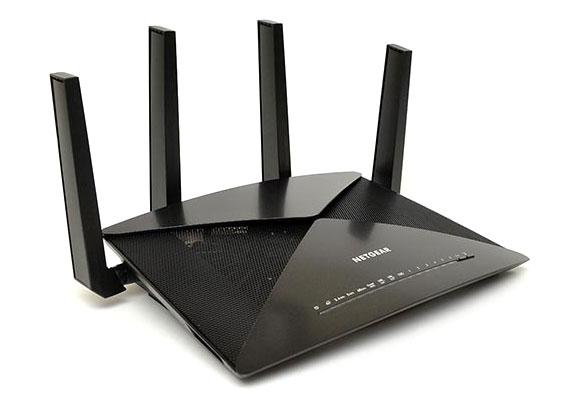Netgear Nighthawk X10 Wireless AD7200 Router Review [Updated]
Introducing the Nighthawk X10 AD7200 Smart WiFi Router (R9000)
Updated: 2/10/2017 - Since we initially launched this article, Netgear assisted with resolving a technical issue we were experiencing with 802.11ad connectivity and performance with the Nighthawk X10 router we had in for testing. As such, we have updated this review with both fresh 60GHz 802.11ad performance data, and we've upgraded our rating to HotHardware Recommended in the conclusion as well.
We’ve reviewed all kinds of 802.11 routers here at Hothardware, including audacious tri-band routers that look like spaceships, and more pedestrian dual-band routers too. The recently released Netgear Nighthawk X10 is something
Before we get too deep in the weeds though, let’s take a look at what the Nighthawk has to offer:
|
| WiFi Band | Simultaneous Tri-Band WiFi - 2.4GHz + 5GHz + 60GHz |
| Beamforming | Implicit & Explicit Beamforming for 2.4 & 5GHz bands |
| Ethernet Ports | Seven (7) 10/100/1000 Mbps Gigabit Ethernet ports: 1 WAN & 6 LAN |
| USB Ports | Two (2) USB 3.0 ports |
| Key Features | 802.11ac Quad-Stream Wave2 WiFi with MU-MIMO—Delivers WiFi to multiple devices simultaneously 60 GHz 802.11ad WiFi—Fastest WiFi interface up to 4.6Gbps for ultra-high speed downloads and backup Plex Media Server—All your movie, TV show, music, and photo collections, on the devices you love Powerful 1.7GHz quad-core processor Four enhanced dual-band Active antennas with high powered amplifiers Link aggregation Amazon Drive cloud back up Six gigabit Ethernet LAN ports and 10G LAN SFP+ port Open source software available |
| Security | 64-bit WEP, 128-bit WEP, WPA2-PSK, WPA-PSK, WPA-Enterprise , WPA2-Enterprise , WPS support |
| Processor | Quad core 1.7GHz processor |
| Memory | 512MB DDR3 DRAM |
| Physical Specs | Dimensions: 12 x 9 x 2.5in |
| Package Contents | R9000 Router Ethernet cable Quick install guide Power adapter |
| Price |
$449.99 currently on Amazon |
Aside from its 802.11ad features, which we’ll get to shortly, the X10 is basically a tri-band router that offers every single bit of the latest technology available. It supports up to 800Mb/s on its 2.4GHz band, up to 1,733Mb/s on its 5GHz band, and up to 4,600Mb/s on its 60GHz band. Netgear is rounding up a bit, but those three combined equal the 7,133Mb/s so it's advertised as an AD7200 router.
In addition to offering next-gen
Why you (might) want 802.11ad
Here’s the real 411 about this newfangled technology; it’s not the successor to 802.11ac, but rather a special type of wireless technology that is ridiculously fast, though it is best for short ranges in most end-user environments. 802.11ad, or WiGig as its also known, actually offers excellent range and low-latency -- much better than other types of Wi-Fi -- in open spaces and with line-of-site connections. But it does not penetrate through most walls or other objects (like people), and must rely of reflections and beam forming in most residential setups.
The main reason why it's included in this router, and this is our opinion not official Netgear marketing speak, is because the X10 has a built-in Plex server and can stream high-def content all on its own, no fancy NAS required. This doesn’t entirely reduce the number of devices needed to pull this off, as you still need a USB storage device connected to the X10 to stream movies, but it can be any USB device or even a flash drive, provided it is fast enough. In the past you needed a high-powered NAS or server capable of 4K video transcoding for Plex, but the X10 has a beefy Annapurna 1.7GHz quad-core SoC that is capable of transcoding 4k video all on its own, making it the first router that we’ve seen that can pull off this level of action without assistance. You can also connect to the router from any internet connection, making it a mobile media server of sorts. Also, we all know there’s less congestion on the 5GHz band compared to 2.4GHz, but there’s practically zero activity on the 60GHz band currently, making it an ideal pathway for high-definition content. Thus the X10 is being marketed as the best router for wireless streaming of 4K content as well as VR gaming.
To pull this off it not only needs that high-powered CPU, but it also features active antennas, where the amplifiers are on the antenna themselves. This router features four non-removable units, and they have blue activity LEDs on them. It supports Wave 2 MU-MIMO for up to four devices on the B/G/N/AC bands, and just one stream for 802.11ad. Since this is a Wave 2 device, it also supports 160MHz channels as well. Finally, there’s a built-in functionality for backing up a connected USB drive to Amazon Cloud.
On the back of the











